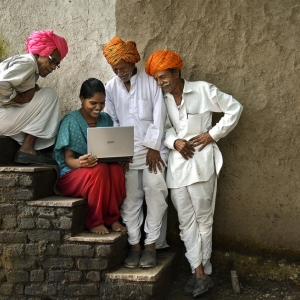[ad_1]
As we were running gender analytics on the Global Findex 2021 microdata, the new AI chatbot Chat GPT was taking the internet by storm. As a test, we asked Chat GPT about two separate themes – the links between gender gaps in financial inclusion, and economic growth and development. We were impressed with Chat GPT’s comprehensive response which highlighted how improved economic indicators could narrow financial inclusion gender gaps. But the answer, of course, did not provide data-backed evidence – so we redirected our attention to spreadsheets and STATA to see what the data had to say.
While the Global Findex 2021 highlighted how the gender gap in account ownership for developing economies has narrowed from 9 to 6 percentage points between 2017 and 2021, there are still significant variations across regions, and some countries like Cote d’Ivoire have witnessed worsening gender gaps. To understand why some countries have made progress while others have stalled or even regressed, we explored whether macro and microeconomic context could be contributing to, driving, or reinforcing gender gaps.
The analysis below shows how four factors – poverty (measured by log GDP per capita), inequality, gaps in human development indicators, and limited connectivity – could be reinforcing gender gaps in account ownership. [Note: This analysis only includes low- and middle-income markets and is only intended to show trends between the variables; the analysis does not establish statistically significant correlations between the variables]
1. Poverty
Unsurprisingly, higher levels of GDP per capita are associated with lower levels of gender gaps in account ownership. The association between poverty and gender gaps in account ownership is stronger for countries above the median income level than below the median income level. We postulate that in countries with lower GDP per capita, women are not contributing as actively to formal GDP, and are therefore not as integrated with the formal financial sector.
However, there are certain outliers to this trend. In Türkiye, for instance, the gender gap in account ownership remains high despite higher per capita incomes than other low- and middle-income countries. Per the World Bank’s Poverty and Shared Prosperity 2022 Report, the COVID-19 pandemic resulted in lower employment and labor force participation across most population groups in the country, with larger effects among women than men. This could further exacerbate gender gaps in financial inclusion in the country.
Sources: World Development Indicators and Global Findex.
Having an account is not the same as using an account. Accounts are sometimes opened without the owner’s knowledge, opened for single-time use, or simply outlive their utility due to changes in circumstances of the owner, or changes in account features. We took the gender analysis a step further to see if economic indicators could be reinforcing gender gaps in account usage. We observe that for countries with higher GDP per capita, women who have accounts tend to use them at rates that come close to men.
2. Inequality
We used the Gini Coefficient as a measure of income inequality (the higher the Gini Coefficient, the higher the income inequality within a country). We observe that countries that have greater income inequality tend to have higher gender gaps in account ownership. According to the Asian Development Bank, young, female, low-skilled workers suffered the brunt of job losses in Indonesia, Malaysia, the Philippines, Thailand, and Vietnam during the COVID-19 pandemic. Similarly, the Poverty and Shared Prosperity Report indicates the labor market has struggled to absorb Egypt’s fast-growing labor force and employment rates for women and youth remain particularly low. This indicates that women could be more disproportionately represented in lower-income segments than men and the links between income inequality and gender gaps in financial inclusion could be explored further.
There are also some outliers in the gender gap in account ownership and inequality trend. In Kosovo, for example, inequality (the Gini Coefficient) is low compared to other middle-income countries, but gender gaps in account ownership are high. This could be because there is a significant gender gap in labor force participation rates in Kosovo. According to the Labor Force Participation Survey, in 2020 the employment rate for men was 49% in comparison to 14% for women. This means that fewer women participate in the formal economy than men, which could explain the gender gaps in account ownership. [Note that we have highlighted the trend, but we did not find the correlation between inequality and gender gaps in account ownership to be statistically significant when we controlled for log GDP per capita]
3. Human Development
As a measure of human development, the Human Development Index (HDI) includes three dimensions spanning education, healthcare, and income. We see that countries that are doing well on human development indicators tend to have lower gender gaps in account ownership. This means gender gaps in account ownership could be driven by factors beyond income and could include socioeconomic factors such as access to essential services like education and healthcare. However, there are some outliers here as well. Algeria, for example, has a high HDI value but also has high gender gaps in account ownership. Algeria, like the rest of the MENA region has experienced a weakening economy in the last few years. Unbanked women who already relied heavily on cash (according to a report released by GPFI, around 1.5 million women in Algeria made or received remittances in cash in 2020) continue to lag men in financial inclusion as a result of weak economic conditions. So, while we acknowledge that human development is important, we cannot assume that countries that have high HDI values necessarily have lower gender gaps in account ownership. [Note that we have highlighted the trend, but we did not find the correlation between HDI and gender gaps in account ownership to be statistically significant when we controlled for log GDP per capita]

Sources: World Development Indicators and Global Findex.
4. Connectivity
Countries with higher internet connectivity tend to have lower gender gaps in account ownership. India is an important outlier, where despite low internet access numbers, there is gender parity in account ownership due to the government’s drive towards opening accounts with public sector banks at scale.
So, what does this mean for women’s financial inclusion? Looking at the trends above, it is evident that the data on gender gaps doesn’t present the regional nuances of women’s financial inclusion across the globe. CGAP previously projected that by 2030, 90% of people living in low- and middle-income countries will have access to an account and 86% will have made or received digital payments, but 330 million people will still be unbanked. From historic trends and what we see above, we think it’s safe to say that a majority of those projected to still be unbanked will be women – particularly those who live in poor regions and face the one-two punch of income inequality and limited access to essential services.
To make matters more complex, over the past three years we have seen a sharp reversal in development gains as measured by GDP per capita growth, inequality, and human development Indicators, owing to global phenomena including inflation, food insecurity, the COVID-19 pandemic, and the war in Ukraine. As per the Poverty and Shared Prosperity Report, poorer countries have been impacted more than their richer counterparts and inequalities within countries have intensified during the pandemic period. For instance, the bottom 40% of populations in Colombia and Peru lost about a quarter of their income between 2019 and 2020, and their incomes declined more than the average rate of contraction.
In this global context, could we achieve gender parity in financial inclusion even if income inequalities and gaps in human development indicators persist, or grow? What can we learn from countries that are outliers? In upcoming blogs, we will be further exploring how the net progress on women’s financial inclusion could be deceptive. Some of the areas we will be analyzing include how gender affects account ownership, and how gender parity in account ownership has not translated into commensurate parity in account usage. Stay tuned for more!
In this blog, gender gaps in financial inclusion refer to the difference between account ownership/usage between men and women.
[ad_2]
Source link



